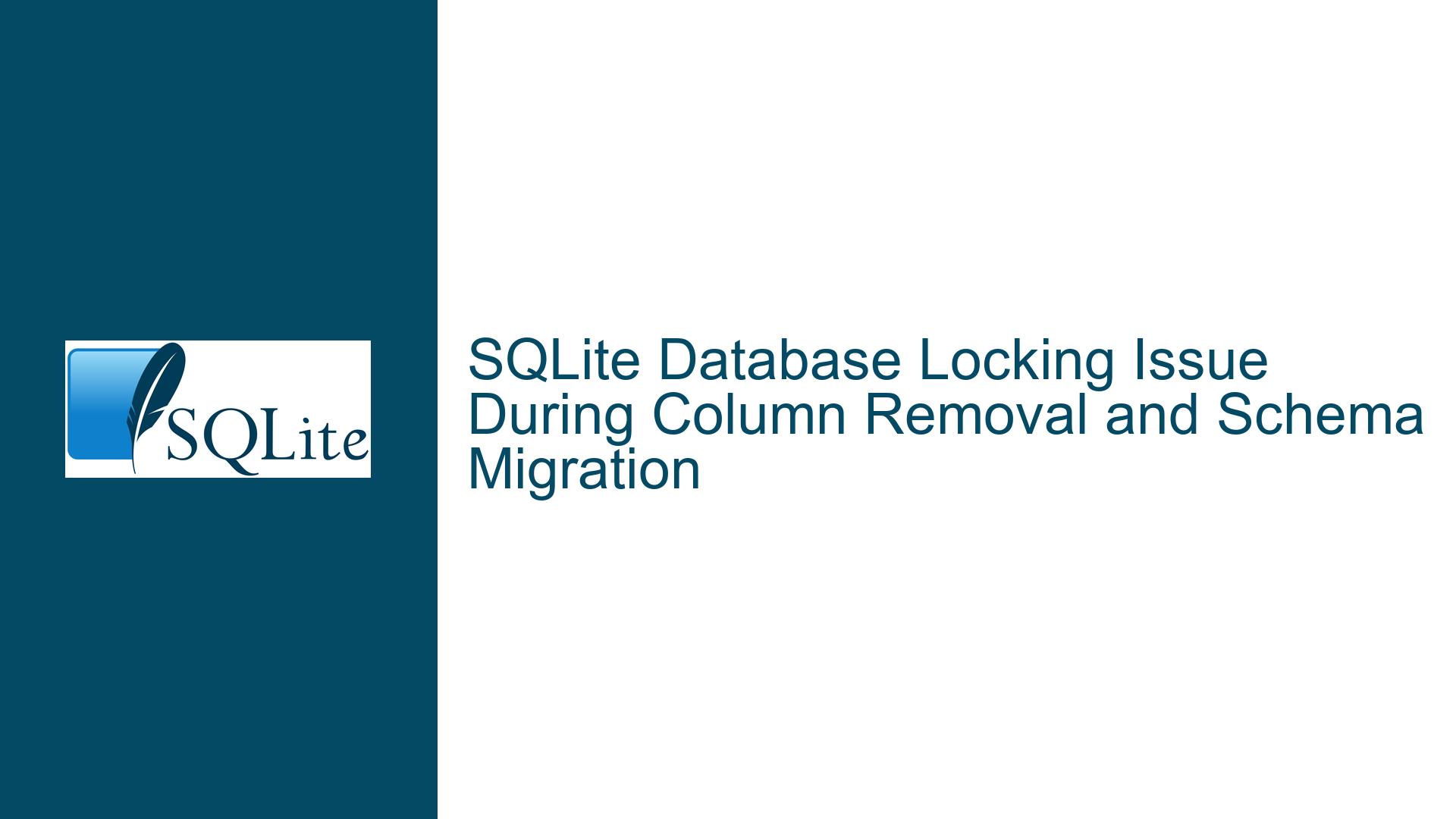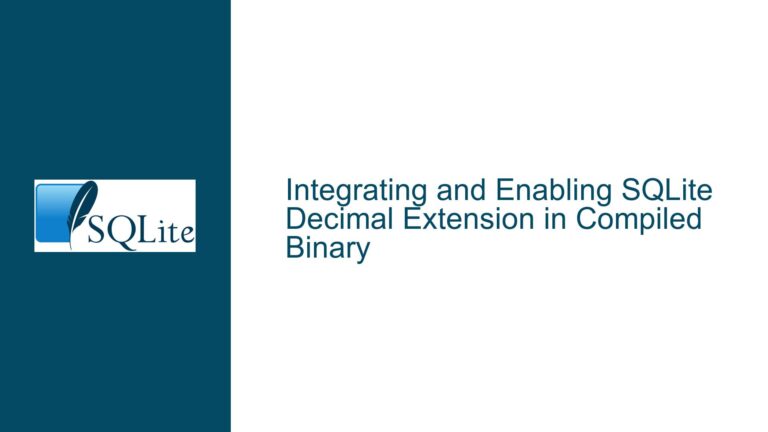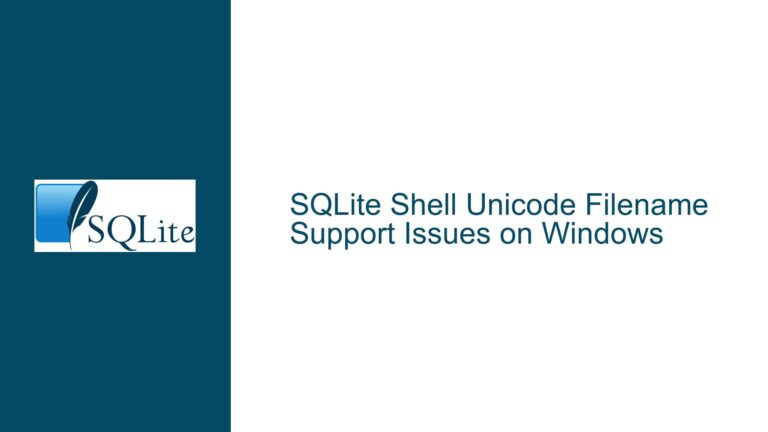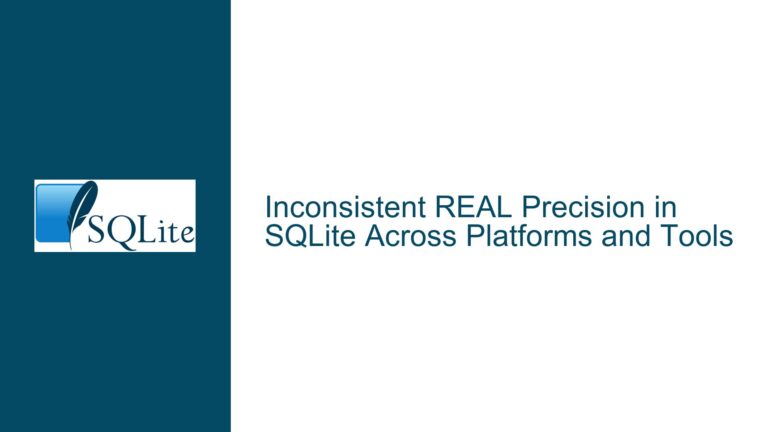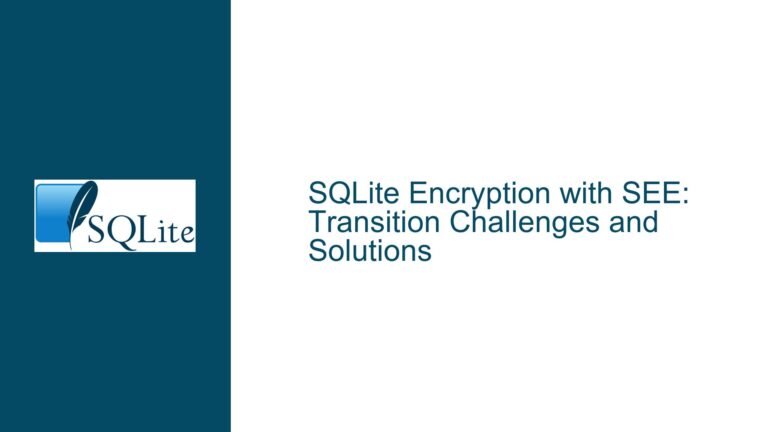SQLite Database Locking Issue During Column Removal and Schema Migration
SQLite Database Locking During Schema Migration
When attempting to remove a column from an SQLite database and replace it with a new one, a common issue that arises is the database table becoming locked. This typically occurs during the execution of a schema migration script, particularly when using a JDBC driver. The error message A table in the database is locked (database table is locked) is indicative of a situation where the database is being accessed by another process or statement that has not been properly finalized or reset. This issue is particularly prevalent when using SQLite in conjunction with JDBC, as the driver may not finalize interim statements correctly, leading to a locked table state.
The problem is exacerbated when the database is in WAL (Write-Ahead Logging) mode, which is a common configuration for improving concurrency and performance. However, WAL mode can also introduce complexities when it comes to schema changes, as it requires careful management of database connections and transactions. The issue is further compounded when using libraries like SqlDelight, which abstract away some of the lower-level details of database interactions, making it harder to diagnose and resolve locking issues.
Interrupted Write Operations and Unfinalized Statements
The primary cause of the database locking issue during schema migration is the presence of unfinalized statements or ongoing transactions that are accessing the table being modified. In SQLite, a table cannot be dropped or altered if there are any active statements or transactions that reference it. This is a safety mechanism to prevent data corruption and ensure consistency. When a SELECT statement is executed, for example, the connection remains open until the statement is explicitly finalized or reset. If this does not happen, the table remains locked, and any subsequent attempts to modify the schema will fail.
Another potential cause is the use of WAL mode, which allows multiple readers and a single writer to access the database concurrently. While this improves performance, it also means that schema changes require exclusive access to the database. If any other process or connection is holding a read lock, the schema change operation will be blocked until all locks are released. This can lead to a deadlock situation if the application is not designed to handle such scenarios properly.
Additionally, the JDBC driver may not be handling the finalization of statements correctly, especially when used in conjunction with higher-level libraries like SqlDelight. These libraries often manage connections and transactions internally, which can lead to situations where statements are not finalized as expected. This is particularly problematic during schema migrations, where the order of operations and the management of transactions are critical to avoiding locking issues.
Implementing Proper Transaction Management and Connection Handling
To resolve the database locking issue during schema migration, it is essential to implement proper transaction management and connection handling. This involves ensuring that all statements are properly finalized and that transactions are explicitly committed or rolled back before attempting any schema changes. Below are detailed steps to troubleshoot and resolve the issue:
Step 1: Ensure Proper Finalization of Statements
The first step in resolving the locking issue is to ensure that all statements are properly finalized before attempting to drop or alter a table. This can be done by explicitly calling the close() method on the Statement object in JDBC after the statement has been executed. For example:
Statement stmt = connection.createStatement();
ResultSet rs = stmt.executeQuery("SELECT * FROM old_table");
// Process the result set
rs.close();
stmt.close(); // Ensure the statement is finalized
If you are using a higher-level library like SqlDelight, you may need to check the library’s documentation to ensure that it handles statement finalization correctly. In some cases, you may need to manually manage the lifecycle of statements to avoid locking issues.
Step 2: Use Explicit Transactions with BEGIN IMMEDIATE
When performing schema changes, it is crucial to use explicit transactions to ensure that the database is in a consistent state before and after the changes. The BEGIN IMMEDIATE transaction mode is particularly useful in this context, as it acquires a write lock on the database immediately, preventing other processes from accessing the table while the schema change is in progress. For example:
BEGIN IMMEDIATE TRANSACTION;
-- Perform schema changes here
COMMIT TRANSACTION;
This ensures that the schema change operation has exclusive access to the database, reducing the likelihood of locking issues. If the schema change fails for any reason, the transaction can be rolled back to maintain database consistency.
Step 3: Disable Foreign Key Constraints Temporarily
Foreign key constraints can also contribute to locking issues during schema changes, as they may prevent certain operations from being performed while the constraints are active. To avoid this, you can temporarily disable foreign key constraints using the PRAGMA foreign_keys command before performing the schema change:
PRAGMA foreign_keys=off;
BEGIN IMMEDIATE TRANSACTION;
-- Perform schema changes here
COMMIT TRANSACTION;
PRAGMA foreign_keys=on;
This ensures that foreign key constraints do not interfere with the schema change operation. However, it is important to re-enable foreign key constraints after the operation is complete to maintain data integrity.
Step 4: Use a New Database for Schema Changes
In some cases, it may be easier to create a new database with the desired schema and migrate the data from the old database rather than attempting to modify the existing schema. This approach avoids many of the locking issues associated with schema changes and can be more reliable, especially in complex scenarios. The following steps outline this process:
Create a New Database: Create a new database with the desired schema, including the new column and any other changes.
Attach the Old Database: Attach the old database to the new database using the
ATTACHcommand:ATTACH '/path/to/old_database.sqlite' AS old_db;Migrate Data: Use
INSERT INTO ... SELECTstatements to migrate data from the old database to the new database. Be sure to specify the column names explicitly to avoid issues with column order or missing columns:INSERT INTO new_table (col1, col2, ...) SELECT col1, col2, ... FROM old_db.old_table;Detach the Old Database: Once the data migration is complete, detach the old database:
DETACH old_db;Replace the Old Database: Replace the old database file with the new database file, ensuring that any file permissions or ownership settings are preserved.
This approach is particularly useful when dealing with large databases or complex schema changes, as it minimizes the risk of locking issues and ensures that the database remains consistent throughout the migration process.
Step 5: Monitor and Manage Database Connections
Finally, it is important to monitor and manage database connections to ensure that no other processes are holding locks on the database while the schema change is in progress. On Unix-based systems, you can use the lsof command to identify processes that have the database file open:
sudo lsof /path/to/your/database.sqlite
This will list all processes that have the database file open, allowing you to identify and terminate any processes that may be holding locks. On Windows, you can use tools like Process Explorer to achieve the same result.
In addition to monitoring connections, it is important to ensure that your application properly manages database connections, closing them when they are no longer needed and using connection pooling to avoid excessive resource usage. This is particularly important in multi-threaded applications, where multiple threads may be accessing the database concurrently.
Conclusion
Resolving SQLite database locking issues during schema migration requires a combination of proper transaction management, careful handling of database connections, and, in some cases, a complete rethinking of the migration strategy. By ensuring that all statements are properly finalized, using explicit transactions, temporarily disabling foreign key constraints, and considering the use of a new database for schema changes, you can avoid many of the common pitfalls associated with schema migration in SQLite. Additionally, monitoring and managing database connections can help identify and resolve issues related to locked tables, ensuring a smooth and successful migration process.
